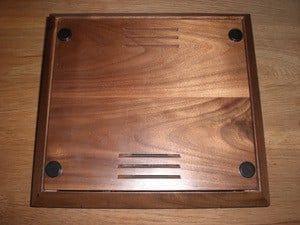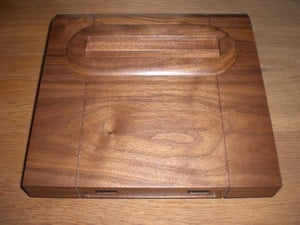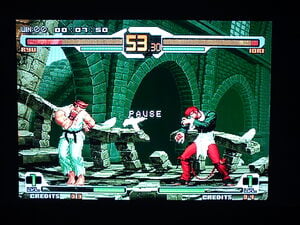While we're a Nintendo site first and foremost, we obviously don't mind reporting on other sectors of the gaming universe. SNK's Neo Geo system is a particular favourite (just try and prise our resident Neo lover Corbie Dillard away from his beloved cab, we dare you) and when we reported on Analogue Interactive's amazing wooden Consolised Neo Geo MVS console a while back, it's fair to say that many of you appreciated hearing the news – as well as being impressed by 100% walnut casing and clean, hand-crafted lines.
We're pleased to report that we're one of the first sites on the face of the planet to get our hands on this wonder machine – in fact, in our clammy palms we currently have the only available example in the world. Pre-orders are open and production is due to ramp up later this month, but in the meantime we're here to tell you why you should be saving those pennies and ordering one of these wooden wonders.
Analogue Interactive's unique machine is based on SNK's Neo Geo MVS (Multi Video System) arcade hardware. The only element that Analogue has manufactured from scratch is the wooden casing – the innards are taken from an MVS arcade unit, many of which are still in active service for public play all over the globe.
A brief history lesson is probably in order at this juncture. To cut a long story short, SNK released two different versions of its popular Neo Geo hardware at the dawn of the 1990s. MVS was intended for arcades, while AES (Advanced Entertainment System) was for home use. The software for these two formats is identical – only the carts themselves are physically different.
The reason for this is that back in the early '90s, AES software was cheaper than MVS software – a move made by SNK to prevent unscrupulous arcade operators from using AES carts in MVS machines (thereby making a bigger profit margin thanks to the cheaper games). However, these days the situation is reversed – MVS carts are very common while the AES versions (which had low print runs and came with proper packaging) can often reach insane prices. For example, the PAL AES edition of Kizuna Encounter is worth thousands of dollars.
Because of this pricing disparity, many Neo Geo fans prefer to collect MVS games as it allows them to enjoy the system's library without having to resort to selling a kidney or remortgaging the family home. While it's possible to play MVS carts on an AES system using a converter, it's not an entirely reliable approach – titles with sprite scaling end up with corrupted graphics while others have glitchy visuals and sound. Bearing this in mind, it's easy to see why the MVS avenue is so appealing.

Analogue Interactive's CMVS is unique in the field firstly because it's pretty easy on the eye. Most CMVS system are rough-looking to say the least; they usually consist of bare circuit boards, plastic cart connectors and a jungle of wires. This is understandable when you consider that the MVS hardware has to be ripped from an arcade cabinet, modded to run on a standard television set and given an appropriate power supply, but for those of us that take pride in the gaming devices beneath our TVs, the typical MVS is always going to seem a bit naked.
"Naked" is not a term that one can so easily apply to Analogue's effort, however. Bedecked in a gorgeous wood casing, this feels more like a piece of expensive Hi-Fi equipment than it does a game console. Everything has been hand-finished, right down to the spring-loaded dust flaps that protect the innards when a cartridge isn't inserted.
Across the back of the console you'll discover a plethora of AV outputs – the only one missing is old-fashioned RF, and we can't imagine many will lament that fact. European gamers will love the inclusion of RGB SCART (which offers fantastic colour and clarity) while those in other parts of the world will be pleased that S-Video makes the cut.

Owners of modern LCD HD televisions will rejoice at the fact that component video is supported, and while we can't imagine that similar shouts of celebration will accompany the news that composite output is also available, it will at least provide solace to those who cannot use any of the other choices.
A component cable is included with the machine, but if you intend to use any other connection you'll have to shell out some additional cash for a lead. Analogue Interactive are prepping their own SCART leads, and given the unique nature of the MVS video modification, it's recommended you don't use any other variants.
Also inside the box you'll discover a multi-region power supply, which will work anywhere in the world. It has a two-pin North American connection, so being UK-based we naturally had to pick up a cheap travel adapter to get the ball rolling.
You're probably wondering by now when controllers are going to mentioned. Sadly, no interface options are included with the Analogue interactive MVS. You'll need to source your own controllers, but thankfully this isn't too much of an issue when you have certain online auction sites at your disposal. Pre-owned AES sticks and pads are pretty common (especially the Neo Geo CD variants) and thanks to their rugged design, they're often as tight and responsive as the day they rolled off the production line. It's an additional cost you'll have to shoulder, but if you're already something of an SNK fan, chances are you may already have an old stick lying around some place anyway.
Another feature worth mentioning is the inclusion of a Unibios 3.0 chip inside the machine. Without wanting to get too technical, this basically allows you to toggle the default configuration of the machine. You can pick between MVS or AES modes; MVS will allow you to rack up credits (just as you would in the arcade) while the domestic (AES) setting will give you a set number of continues, plus other home-related options. You can also pick the region (some games remove blood on the North American setting), listen to music and even enable a cheat mode, depending on the game in question.

The Analogue Interactive CMVS is quite possibly the sexiest piece of video gaming hardware we've yet laid eyes on, and it has single-handedly rekindled our love of SNK's legendary system. However, it's obvious that not everyone is going to be able to afford the $650 (plus shipping) asked for one of these machines. In anyone's book that's a lot of money – especially for a system that is now over twenty years old. However, as stupid as it may sound, this is actually astonishingly good value.
Most professionally-modded CMVS systems fetch a price that isn't a million miles away from this price figure, and when you consider that you're getting a hand-crafted casing that's practically a work of art, it makes the deal seem even more agreeable. MVS software is also reasonably cheap, so building up a collection for this beauty is actually easier than it sounds – certainly much cheaper than it would be if you were looking at amassing an extensive AES library.
Such a machine is clearly going to be out of reach for many gamers, but if you're old enough to remember when the Neo Geo was spoken about in the school playground in hushed, reverent tones, then chances are you're now approaching your thirties and have more than a little disposable income.
We'd also be willing to bet that you're currently reaching for your credit card and are mentally totting-up how many months you can survive on just bread and water. While we naturally don't condone starving yourself in order to afford such frivolous purchases, we will say this – Analogue Interactive's marvellous walnut console not only provides years of vintage-themed gaming goodness, it's an investment that's only going to gain value as time marches irresistibly onwards. And with that thought burning a hole in your mind (and wallet), we'll get back to playing Metal Slug.
